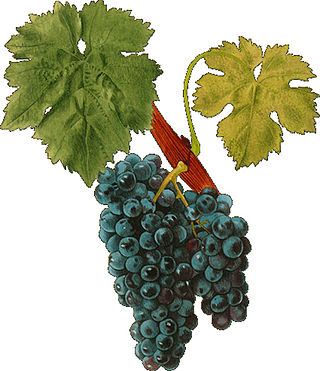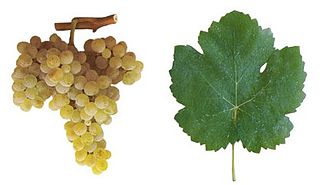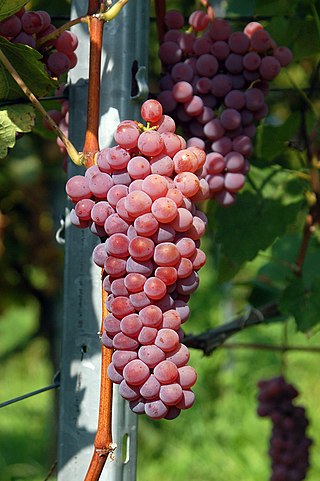
Aurore is a white complex hybrid grape variety produced by Albert Seibel and used for wine production mostly in the United States and Canada. Over a long lifetime Seibel produced many complex hybrid crosses of Vitis vinifera to American grapes. It is a cross of Seibel 788 and Seibel 29.

Carignan is a red grape variety of Spanish origin that is more commonly found in French wine but is widely planted throughout the western Mediterranean and around the globe. Along with Aramon, it was considered one of the main grapes responsible for France's wine lake and was a substantial producer in jug wine production in California's Central Valley but in recent years, it has been reborn as a flagship wine for many cellars in the south of France as well as in Catalonia.

Macabeo, also called Viura or Macabeu, is a white variety of wine grape.
Robola is a white Greek wine grape variety that is grown primarily on the Ionian island of Cephalonia. Historically the vine was thought to be the same variety as the Friuli wine grape Ribolla and was thought to have been brought to northeast Italy by Venetian merchants trading with Cephalonia in the 13th century. However, DNA profiling in the 21st century has cast doubt on that theory and today Robola is classified by the Vitis International Variety Catalogue (VIVC) as a separate variety.

Bical is a white Portuguese wine grape planted primarily in the Bairrada region. It can produce high acid wines and is often used in sparkling wine production.
The Vitis International Variety Catalogue (VIVC) is a database of various species and varieties/cultivars of grapevine, the genus Vitis. VIVC is administered by the Geilweilerhof Institute for Grape Breeding in Siebeldingen, Germany, and contains information from grapevine collections existing in various institutes of viticulture around the world. As of April 2009, the information in the database brought together information from 130 institutions located in 45 countries, and contains about 18,000 entries.
Biancame is a white Italian wine grape variety that is grown in the Marche and Emilia-Romagna regions of Italy. Here it is an important component in the Denominazione di origine controllata (DOC) wines of Bianchello del Metauro and Colli di Rimini.

Calitor or Calitor noir is a red French wine grape variety. It was previously widely cultivated in southern France, in particular in Provence, but is now very rare, almost extinct. Historically used as mainly a blending variety, Calitor gives high yields and produces a light-bodied and lightly colored wine. When grown on hillside sites, it can give a wine of character.

Incrocio Manzoni or Manzoni grapes is a family of grape varieties named after Professor Luigi Manzoni (1888-1968) of Italy's oldest school of oenology located in Conegliano, in the Veneto region. Manzoni created the new grape varieties by selecting, crossing and grafting vines from various vineyards during the 1920s and 1930s. The family includes both white and red grape varieties. Although most Manzonis are grown in northeastern Italy, they are mainly grown in the Piave area of Province of Treviso and are only now starting to be sold commercially in Europe and the United States.
Terrantez is a white Portuguese wine grape variety that was once widely used on the island of Madeira to make the sweet fortified wine for which the island is known. Today, the variety is nearly extinct on the island. There are still some limited plantings in the Minho Province where, as Cascal, is a permitted blending variety with Alvarinho and other grapes in the Denominação de Origem Controlada (DOC) wine Vinho Verde. As Terrantez the grape is permitted in several of the Indicação de Proveniencia Regulamentada (IPR) regions of the Azores including Biscoitos IPR on Terceira Island, Graciosa IPR on the white island of Graciosa and Pico IPR on Pico Island.
Téoulier is a red French wine grape variety found in south east France. Ampelographers speculate that the grape may have originated around the Provençal town of Manosque due to the town's close association with several synonyms of the variety. For most of the 20th century, plantings of Téoulier have steadily declined and today is rarely found.
Cascade is a red complex hybrid grape variety that was created by French viticulturist Albert Seibel in the early 20th century in Aubenas, Ardèche, in the Rhône Valley. It has been commercially available in North America since 1938 and has since been planted in Canada and the United States. However, in warmer climates the grape is highly susceptible to a number of grapevine viruses, which has discouraged plantings of the variety.
Bouteillan noir is a red French wine grape variety that is grown in the Provence wine region of southern France. While the grape has been recorded growing in the Vaucluse region since at least the early 18th century, today the grape is virtually extinct. Despite sharing synonyms with another Provençal grape, Calitor, and the Languedoc wine grape Aramon noir, Bouteillan noir has no known relationship with either of those variety. The white Provençal grape Colombaud was once thought to be a white berried color mutation of Bouteillan noir but research conducted by Dr. Linda Bisson of the University of California, Davis shows that while the two grapes are likely related, one is not a color mutation of the other.
Canari noir is a red French wine grape variety that has been historically grown in the Ariège department in the foothills of the French Pyrénées. However DNA profiling in 2001 showed that plantings of a grape called Gamay Luverdon growing in the Italian wine region of Piedmont were in fact plantings of Canari noir. Across the Pyrénées in Spain, the grape variety known as Batista was also found to be identical to Canari noir. Like Pinot noir and Grenache, Canari noir has color mutations known as Canari blanc and Canari gris.
Ravat blanc is a white hybrid grape variety that is a crossing of Chardonnay and a Seibel grape. While the Vitis International Variety Catalogue (VIVC) maintained by the Geilweilerhof Institute for Grape Breeding list Seibel 5474 as the second parent, Master of Wine Jancis Robinson notes that other authors list Seibel 8724 as the parent. The grape is often confused with the white hybrid grape Vignoles that is often called just Ravat.
Seyval noir is a red hybrid grape variety that was created in the late 19th century by French horticulturalist Bertille Seyve and his father-in-law Victor Villard from a crossing of two Seibel grapes. The pair used the same two variety to create the white wine grape Seyval blanc making the two siblings rather than color mutations of one or the other. The name Seyval comes from a combination of the two men's names.

Souvignier gris is a white German wine grape variety that was created in 1983 Dr. Norbert Becker by crossing the red French wine grape variety Cabernet Sauvignon with the white German grape crossing previously created by Becker known as Bronner. Bronner is a crossing of the hybrid varieties Merzling and Gm 6494.
Blanc du Bois is an American hybrid grape that was created in 1968 by John A. Mortensen at the University of Florida’s Central Florida Research and Education Center in Leesburg, Florida. Mortensen created this variety by crossing various Vitis vinifera grape varieties such as Golden Muscat with native Florida varieties. When released in 1987, Blanc du Bois became another grape variety in the small but growing number of vine types that can both produce marketable wine on their own yet can withstand Pierce's Disease, a bacterial infection that destroys nearly all vinifera vinestocks imported into the southern United States.








